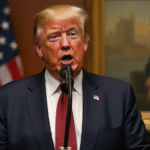Background on Gabriel Lozano and His Relevance
Gabriel Lozano is the Mexico economist at J.P. Morgan, a leading global financial services firm. His expertise and insights on the Mexican economy make him a crucial voice in understanding the potential impacts of recent trade-related developments. As the U.S. and Mexico navigate new tariffs and renegotiate the T-MEC, Lozano’s analysis sheds light on how these actions may affect Mexico’s economic growth and investment decisions.
EU Tariffs and T-MEC Renegotiation: Extending Trade Uncertainty
According to Lozano, the imposition of a 30% tariff on Mexican exports by President Trump and the ongoing review of the T-MEC (Trade Agreement between Mexico, the United States, and Canada) could prolong trade uncertainty until 2027. This extended period of uncertainty may influence investment decisions negatively.
T-MEC Review and Potential Renegotiation
Lozano explained to El Economista that a delay of over a year in the T-MEC review process could likely result in a renegotiation, opening the door to bilateral agreements instead of the current tripartite scenario. This shift would significantly alter the landscape for Mexico’s trade relations.
Mexico’s Economic Growth Projections
J.P. Morgan currently predicts 0% growth for Mexico’s GDP in 2023, with a modest advance of 1% anticipated for 2026. Lozano describes this as a “moderate recovery and rather mediocre growth.”
It’s important to note that these projections do not yet account for the potential impact of aggressive changes in U.S. migration policy and deportations, which could reduce remittances and consumer spending.
Monetary Policy as the Primary Stimulus
With limited industrial policy support and ongoing fiscal consolidation extending through 2026, Lozano emphasizes that monetary policy remains the primary mechanism to stimulate Mexico’s economy. Banco de México (Banxico) is expected to continue its cycle of interest rate reductions, lowering the benchmark rate to 6.50% by early 2024.
Flexibility in Monetary Policy
Despite the projected interest rate reductions, Lozano notes that Banxico will maintain a neutral stance. Victoria Rodríguez Ceja, Banxico’s governor, has highlighted that these adjustments are providing the monetary policy with greater flexibility to respond in any direction.
Lozano clarifies that this flexibility does not imply an imminent rate hike but allows Banxico to pause if necessary, should inflation fail to decline in upcoming quarters, particularly during September and November.
Key Questions and Answers
- What is the current GDP growth projection for Mexico? J.P. Morgan predicts 0% growth for Mexico’s GDP in 2023, with a tentative 1% advance expected for 2026.
- How might EU tariffs and T-MEC renegotiation impact Mexico’s economy? These developments could prolong trade uncertainty until 2027, potentially influencing investment decisions negatively.
- What role does monetary policy play in stimulating Mexico’s economy? With limited industrial policy support and fiscal consolidation, monetary policy remains the primary mechanism to stimulate Mexico’s economy. Banco de México is expected to continue reducing interest rates.
- How flexible is Banxico’s monetary policy? Banxico’s monetary policy has gained flexibility through recent interest rate adjustments, allowing it to respond in any direction as needed.






